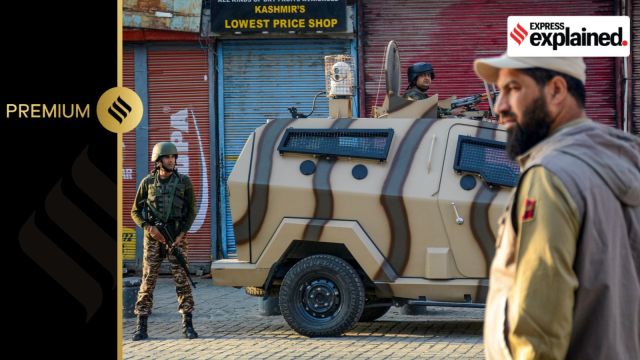The latest encounter in Jammu and Kashmir’s Doda district has once again laid bare the gaps in the security infrastructure of a belt that saw long stretches of peace until recent years.

In January, former Army Chief General Manoj Pande acknowledged that terrorism in that area had been brought under control by 2003, and the region saw peace till 2017-18. However, he admitted that India’s adversaries have been actively abetting terrorism and encouraging “proxy tanzeems (groups with a common objective)” in this area, even as the situation in the Kashmir Valley was getting back to normal.
While there were three attacks each in the Jammu region against security forces in 2022 and 2023, six attacks have been recorded so far this year.
Significantly, six security force personnel were killed in separate attacks in 2022. This increased to 21 last year, and stands at 11 this year. Five militants have been killed in the region so far this year. In 2023, this figure was 20, and in 2022, 14 militants were killed. Eleven civilians have also lost their lives in the attacks this year.
The Indian Express spoke to defence and security sources as well as J&K Police officers to understand the reasons for this surge in violence. They pointed to a few possible factors.
🔴 With peace lasting for several years, and the Valley being more active, some amount of complacency may have crept into the counter-insurgency mindset of the forces deployed in Jammu division, leading to inadequate number of proactive operations.
Story continues below this ad
“The level of alertness in the Valley has remained higher, both in terms of military preparedness and mental anticipation of likely militant actions,” an official said. “Counter-insurgency forces have their drills fine-tuned for all operational tasks, such as patrolling, ambush and even routine activities like convoy movement. Even minor slippages in the drills have been known to cause major losses,” the official said.
Moreover, the troop reduction in the region with the movement of forces to the Line of Actual Control in 2021 led to an increased area of responsibility for each battalion, contributing to an increased revisit time by every patrol. It is understood that around 4,000 to 5,000 troops, mostly involved in counter-terror duties, were moved out of the area in 2021.
🔴 The recent attacks westwards of Jammu in the Kathua-Samba region also point towards another trend – of carrying out attacks close to the International Border. “Unlike Rajouri and Poonch, these areas, even though part of Jammu region, come under the Army Western Command, which does not undertake counter-terror operations,” an official said.
The official added that while additional troops may be deployed in the region in the days to come from peacetime locations, they will first need to be trained and will need a familiarisation period.
Story continues below this ad
Sources in the state police too said that Jammu has been made the new theatre of operations against security forces by militant outfits as a planned strategy. “After the changes to J&K’s constitutional status in 2019, the Valley settled into a quieter state and then Galwan (Eastern Ladakh) flared up in 2020. After that, attacks began more frequently in Jammu. So there’s three fronts open for the forces, including Kashmir,” the source said.
Additionally, sources said, “infiltration along the IB is comparatively easier than the LoC”. The attacks, police sources said, are being led by cadres of the Jaish-e-Mohammad and the Lashkar-e-Taiba.
After 2007, when militancy ebbed in the Jammu region, deployment patterns changed, and in the last few years, “thin deployment led to some gaps geographically and subsequently to poor intelligence”, officials said. They emphasised that border management is key to handling the increased militant activity in the region, while “also remaining cautious in the Valley, since the shifting focus on Jammu allows militant outfits to regroup in Kashmir”.
🔴 A top security official also pointed out that with increased dependence on technology, there is a likelihood of a reduced ground connect, which has been known to deliver the best operational intelligence. As a result, there may be efforts soon to “reorient the operational philosophy to basic source counter-insurgency operations”, sources said.
Story continues below this ad
“Lack of adequate ground-level intelligence and hardened and motivated terrorists with meticulous planning are major contributing factors,” an official said.
Sources in the J&K Police too linked the uptick in incidents of terror violence in Jammu to a lack of “human intelligence” feeding security forces. And while “that is changing, developing these networks will take time”, they said.
Officials also said that nearly all the attacks in the Jammu region have been carried out by foreign terrorists. “They are mainly using Kathua and parts of Samba to infiltrate into Indian territory and carry out these attacks using the dense forest cover. What would be most useful here is human intelligence and that has been lacking in Jammu for the last few years,” a senior security official said.
Officials further said that “motivational incentives” for the forces, such as “promotion of SPOs to constables”, are on the “back-burner due to centralisation of powers in the police”, which can further reduce incentives for developing human intelligence.
Story continues below this ad
🔴 Officials also said militants are bringing sophisticated equipment such as night-vision glasses and M4 rifles. Plus, there have also been increased instances of narco-terrorism, facilitated both by people and drones, generating adequate funds for distribution to locals and to fund terror activities. Several drones transporting drugs, explosives, weapons and money have been caught in the region by security forces in the last few years.
An increased inflow of funds can enhance the network of overground workers (OWGs), officials said.








































